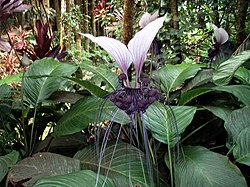Tacca
 From Wikipedia - Reading time: 7 min
From Wikipedia - Reading time: 7 min
| Bat flowers | |
|---|---|

| |
| White Bat Flower (Tacca integrifolia) | |
| Scientific classification | |
| Kingdom: | Plantae |
| Clade: | Tracheophytes |
| Clade: | Angiosperms |
| Clade: | Monocots |
| Order: | Dioscoreales |
| Family: | Dioscoreaceae |
| Genus: | Tacca J.R.Forst. & G.Forst. |
| Synonyms[1] | |
| |
The genus Tacca, which includes the batflowers and arrowroot, consists of flowering plants in the order Dioscoreales, native to tropical regions of South America, Africa, Australia, Southeast Asia, and various Oceanic islands.[1] In older texts, the genus was treated in its own family Taccaceae, but the 2003 APG II system incorporates it into the family Dioscoreaceae.[2] The APG III and APG IV systems continue to include Tacca in Dioscoreaceae.[3][4]
Description
[edit]Many Tacca species have nearly black flowers, with conspicuous involucral bracts and bracteoles like whiskers.[5] Engbert Drenth hypothesized that species of this genus attracted "carrion and dung flies" for pollination and that the fleshy seam of the seed might be attractive to ants and hence that ants might aid in seed dispersal.[6]
Taxonomy
[edit]Earlier classifications placed the genus within the monogeneric family Taccaceae, which in turn was the sole family in the order Taccales. Dahlgren recognised the similarities to the genera within the Dioscoreales, and incorporated the family into that order.[7]
Subdivision
[edit]There are at least 16 species,[8]
- Tacca ampliplacenta L.Zhang & Q.J.Li - Yunnan
- Tacca ankaranensis Bard.-Vauc., 1997 - Madagascar
- Tacca bibracteata Drenth - Sarawak
- Tacca borneensis Ridl. - Borneo
- Tacca celebica Koord. - Sulawesi
- Tacca chantrieri André, 1901 - Indochina, Assam, Bangladesh, Tibet, Guangdong, Guangxi, Guizhou, Hainan, Hunan, Yunnan
- Tacca ebeltajae Drenth - Papua New Guinea, Solomon Islands
- Tacca integrifolia Ker Gawl., 1812 - Tibet, Bhutan, Assam, Bangladesh, Indochina, India, Pakistan, Java, Malaysia, Sumatra, Borneo
- Tacca leontopetaloides (L.) Kuntze, 1891 - widespread across tropical Africa, Madagascar, Indian Subcontinent, Southeast Asia, New Guinea, Australia, and various islands of the Indian and Pacific Oceans
- Tacca maculata Seem., 1866 - Western Australia, Northern Territory, Fiji, Samoa
- Tacca palmata Blume - Indonesia, Indochina, Malaysia, Philippines, New Guinea
- Tacca palmatifida Baker - Sulawesi
- Tacca parkeri Seem. - South America
- Tacca plantaginea (Hance) Drenth, 1972 - Indochina, southern China
- Tacca reducta P.C.Boyce & S.Julia - Sarawak, Borneo, Malesia
- Tacca subflabellata P.P. Ling & C.T. Ting, 1982 - Yunnan
- Tacca lanceolata Spruce - Brazil, Venezuela = Tacca parkeri Seem.[9][10]
Cultivation
[edit]Several species are cultivated as ornamental plants for their bold foliage and large flowers. The well-known T. chantrieri goes by the names of black batflower, bat-head lily, devil flower or cat's whiskers. Tacca integrifolia is known as the purple or white batflower. Other cultivated varieties include the arrowroot, T. leontopetaloides, and T. cristata aspera.[11][12]
Gallery
[edit]-
Black bat flower, Tacca chantrieri, close-up of flower
-
Tacca cristata, flowering
-
Ankarana arrowroot, Tacca ankaranensis, flower
-
Polynesian arrowroot, Tacca leontopetaloides, mature plants
References
[edit]- ^ a b "Tacca J.R.Forst. & G.Forst". Plants of the World Online. Royal Botanic Gardens, Kew. 2023. Retrieved 15 March 2023.
- ^ Caddick, L. R., P. Wilkin, P. J. Rudall, T. A. J. Hedderson & M. W. Chase. 2002. Yams reclassified: a recircumscription of Dioscoreaceae and Dioscoreales. Taxon 51(1): 103–114.
- ^ Angiosperm Phylogeny Group (2009). "An update of the Angiosperm Phylogeny Group classification for the orders and families of flowering plants: APG III". Botanical Journal of the Linnean Society. 161 (2): 105–121. doi:10.1111/j.1095-8339.2009.00996.x. hdl:10654/18083. ISSN 0024-4074.
- ^ Angiosperm Phylogeny Group (2016). "An update of the Angiosperm Phylogeny Group classification for the orders and families of flowering plants: APG IV". Botanical Journal of the Linnean Society. 181 (1): 1–20. doi:10.1111/boj.12385. ISSN 0024-4074.
- ^ Ling Zhang; Spencer C H Barrett; Jiang-Yun Gao; Jin Chen; W. W. Cole; Yong Liu; Zhi-Lin Bai; Qing-Jun Li (1 March 2005). "Predicting mating patterns from pollination syndromes: the case of "sapromyiophily" in Tacca chantrieri (Taccaceae)". American Journal of Botany. 92 (3): 517–524. doi:10.3732/AJB.92.3.517. ISSN 0002-9122. PMID 21652430. Wikidata Q39626349.cite Q
- ^ Engbert Drenth (1972). "A revision of the family Taccaceae". Blumea. 20 (2): 367–406. ISSN 0006-5196. Wikidata Q96027961.
- ^ Dahlgren & Clifford 1982.
- ^ Catalogue of Life: 2017 Annual Checklist Tacca
- ^ Catalogue (2017)
- ^ Tropicos
- ^ Govaerts, R., Wilkin, P. & Saunders, R.M.K. (2007). World Checklist of Dioscoreales. Yams and their allies: 1-65. The Board of Trustees of the Royal Botanic Gardens, Kew.
- ^ Flora of China, Vol. 24 Page 274, 蒟蒻薯属 ju ruo shu shu, Tacca J. R. Forster & G. Forster, Char. Gen. Pl. 35. 1775.
Bibliography
[edit]- Dahlgren, Rolf; Clifford, H. T. (1982). The monocotyledons: A comparative study. London and New York: Academic Press.
- Germplasm Resources Information Network: Tacca
- Taccaceae in L. Watson and M.J. Dallwitz (1992 onwards), The families of flowering plants Archived 2007-01-03 at the Wayback Machine
- Huxley, A., ed. (1992). New RHS Dictionary of Gardening. Macmillan.
 KSF
KSF



